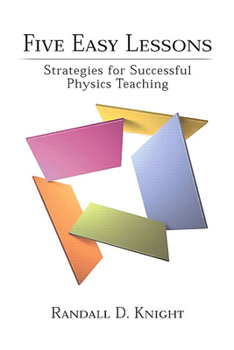Five Easy Lessons: Strategies for Successful Physics Teaching
Five Easy Lessons: Strategies for Successful Physics Teaching is a paperback book packed with creative tips on how instructors can enhance and improve their physics class instruction techniques. It's an invaluable companion to Randy Knight's Physics for Scientists and Engineers -- or for any physics course.
Format:Paperback
Language:English
ISBN:0805387021
ISBN13:9780805387025
Release Date:September 2002
Publisher:Pearson
Length:352 Pages
Weight:0.91 lbs.
Dimensions:0.7" x 6.0" x 9.1"
Customer Reviews
5 ratings
Best Resource I've Found
Published by Thriftbooks.com User , 16 years ago
I don't know if I would call these lessons easy, but they certainly are successful. This book is simply amazing. It starts with an overview of pedagogical methods for teaching physics, ideas for general teaching philosophy, and research-based active learning techniques. Once it gets into the nitty gritty of the topics, it goes through every topic pointing out common misconceptions students have, ways to gently convince them that they are wrong (conventional physics education may teach them how to use equations, but it doesn't change anything about how they think the world works) and nudge them towards the correct intuition. I just finished going through yet another day of electric field and potential with my physics students, and the activities he suggests really helped them grasp these intangible concepts and how they interact. I would have never thought of the things in this book on my own, but once I got it I immediately tossed "talking-head" lectures out the window and now my students do physics WITH me and solve problems together and get instant feedback on problems to keep them on the path I want them to be on. If you teach physics at any level, this book is helpful for combating incorrect "knowns" about the universe, but it is utterly invaluable if you teach at the honors or college level.
Physics meets Active Learning
Published by Thriftbooks.com User , 17 years ago
Physics is hard. This makes it easier. Thankfully, another professor lent me his copy of this book when I first started teaching Introductory Physics otherwise I would have been sunk. After three years, I still read the corresponding chapter from this book before preparing a chapter for the class. There are so many useful tidbits which have helped my students. Knight has combined physics education research with active learning methods to help students to learn both concepts and problem-solving. And he has done so in a concise, relevant text for teachers. As frustrated as I am with many of my student's inability to grasp physics, they are far, far better off than if I had not been given this book. Every physics teacher should have a well-worn copy on their desk!!!
A must for successful physics instruction
Published by Thriftbooks.com User , 18 years ago
I found this book invaluable for teaching my AP Physics class. It lays out inquiry based instruction for all levels of physics and backs its claims with physics education research. This book additionally discusses particular subjects within the physics curriculum and defines the misconceptions that students often bring to the classroom. Prior know of these misconceptions helps the instruction in lesson planning and labs.
An Invaluable Resource for Physics Educators
Published by Thriftbooks.com User , 19 years ago
Five Easy Lessons is written not so much for students of the subject as for those who must teach them. Far too often, the process of this teaching either assumes the student as Tabla Rasa or gives little thought to the previous knowledge state of the student. Knight's book is an excellent way to move beyond these assumptions and to get an idea of the misconceptioins and alternative conceptions that will impede a student's ability to learn the subject. The book is broken up into two sections. The first section covers the broad generalities of teaching physics, physics education research and implementing an active-learning environment in the classroom. These chapters will be of great use to the educator trying to understand how to move away from lectures and verification labs into something more effective. The second section discusses the particulars of teaching each major subject area within physics including suggested class schedules as well as specific misconceptions to be addressed. I would strongly recommned this book to two groups: any educator looking to move from a traditional educational setting to an active-learning environment and those high school level educators who need to review their physics background in preparation for teaching the subject, especially if the subject is being taught out of field.
hands-on experiments
Published by Thriftbooks.com User , 20 years ago
Why do so many students have problems with physics? Part of it is just aptitude. You really do need a natural fluency with maths to go far into physics. But even so, there are basic physics ideas that can be usefully understood at a qualitative level, by those who will take no other courses in physics. It is perhaps for such students that Knight addresses his book. He tries to grab your interest. In part by describing ideas as eloquently as he can. But also by suggesting experiments that illustrate key ideas, and which are hands-on, without demanding abstruse maths sophistication on your part. And which do not need elaborate and expensive apparatus to set up. He has derived these in large part from his own, long experience in teaching physics. Hopefully, you might learn something from this text.





